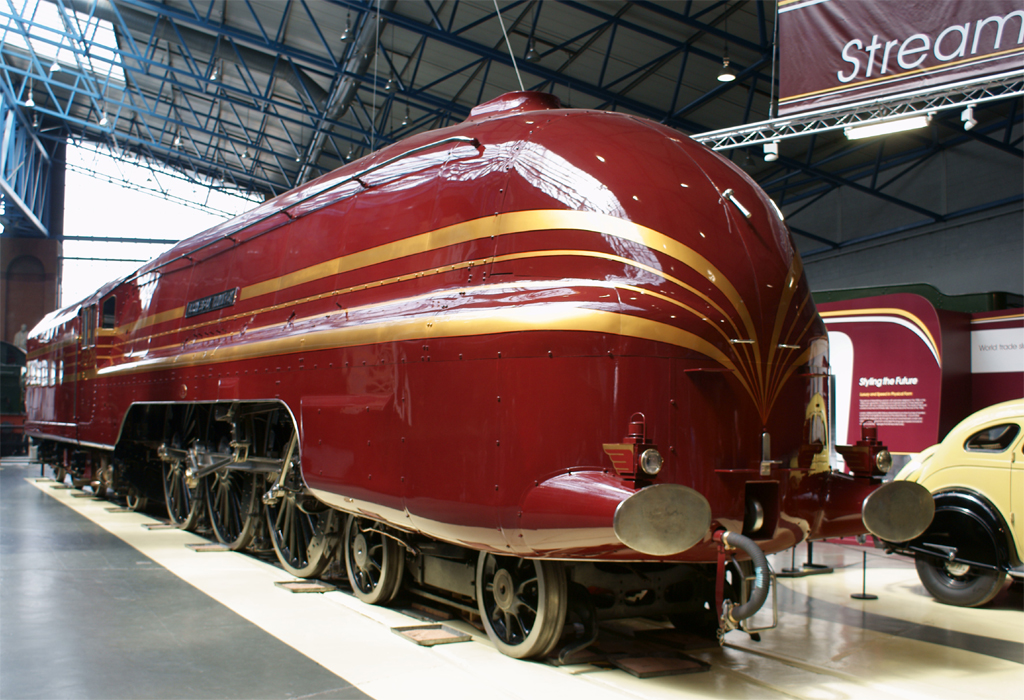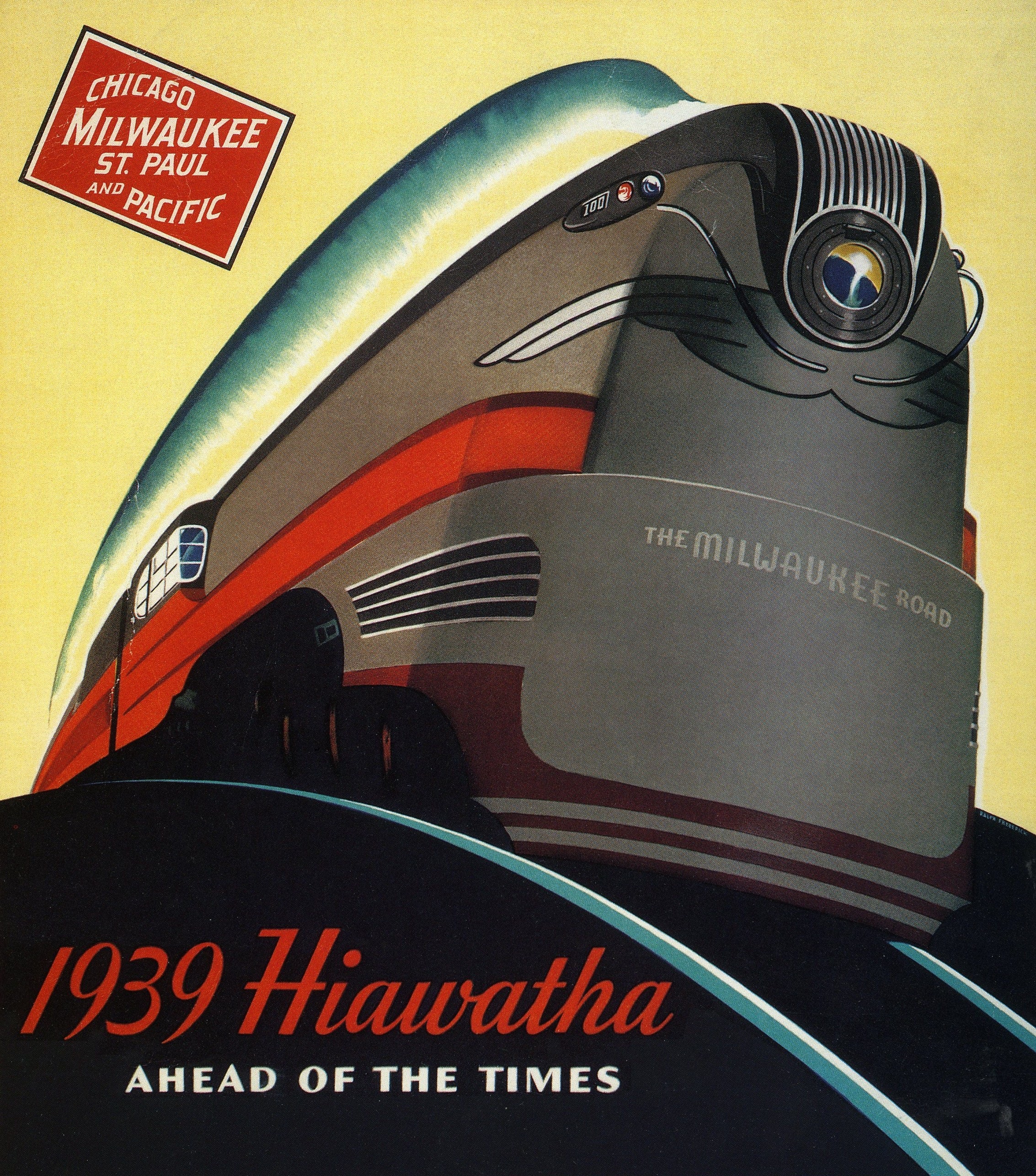|
Beaver Tail (American Railcar)
The Beaver Tails were a fleet of streamlined parlor-observation passenger cars built by the Chicago, Milwaukee, St. Paul and Pacific Railroad ("the Milwaukee Road") between 1934–1938. They served as the observation cars on the famous ''Hiawatha'' trains from 1935 until 1948, when they were displaced by the new Skytop Lounge. The cars' name was derived from the distinctive flat, sloped rear of the car. Design The Beaver Tails were constructed in three distinct batches, corresponding to the introduction of the ''Hiawatha'' in 1934 and its first two reequippings in 1936 and 1938. In total eight cars were built, all in the Milwaukee Road's own shops. The first generation seated 24 in the rear area, plus separate men's and women's lounges. In the 1936 edition the lounges were replaced by "small toilet rooms"; there was lounge-style seating for 26 plus seating for 12 in the rear (dubbed the "solarium"). The final version (pictured at right), built in 1938, was designed by the r ... [...More Info...] [...Related Items...] OR: [Wikipedia] [Google] [Baidu] |
Midwest Hiawatha
The ''Midwest Hiawatha'' was a passenger train on the Milwaukee Road, one of many Milwaukee Road trains with a ''Hiawatha'' name. The service began December 11, 1940 between Chicago's Union Station and Omaha, Nebraska, Sioux Falls, South Dakota, through northern Illinois and Iowa and South Dakota. Initially the train used Atlantic 4-4-2 steam engines and cars freed by the 1938 re-equipping of the ''Twin Cities Hiawathas'', including the distinctive Beaver Tail parlor-observation cars. In 1940 the train covered between Chicago and Omaha in 480 minutes. Unlike the competition between Chicago and the Missouri River, the ''Midwest Hiawatha'' was scheduled during daylight, which helped boost patronage. For most of its history, it carried coaches for both Omaha and Sioux Falls with tap-diners and parlor services generally run between Chicago and Sioux Falls. The two sections of the train split at Manilla, Iowa. The final trips for the ''Midwest Hiawatha'' were on October 29, 1955. ... [...More Info...] [...Related Items...] OR: [Wikipedia] [Google] [Baidu] |
Streamliner
A streamliner is a vehicle incorporating wikt:streamline, streamlining in a shape providing reduced air resistance. The term is applied to high-speed railway trainsets of the 1930s to 1950s, and to their successor "High-speed rail, bullet trains". Less commonly, the term is applied to fully Bicycle fairing, faired upright and recumbent bicycles. As part of the Streamline Moderne trend, the term was applied to passenger cars, trucks, and other types of light-, medium-, or heavy-duty vehicles, but now vehicle streamlining is so prevalent that it is not an outstanding characteristic. In Land speed record, land speed racing, it is a term applied to the long, slender, custom built, high-speed vehicles with enclosed wheels. Trains Before World War II Europe The first high-speed streamliner in Germany was the "Schienenzeppelin", an experimental propeller driven single car, built in 1930. On 21 June 1931, the car set a speed record of on a run between Berlin and Hamburg. In ... [...More Info...] [...Related Items...] OR: [Wikipedia] [Google] [Baidu] |
Observation Car
An observation car/carriage/coach (in US English, often abbreviated to simply observation or obs) is a type of railroad passenger car, generally operated in a passenger train as the rearmost carriage, with windows or a platform on the rear of the car for passengers' viewing pleasure. The cars were nearly universally removed from service on American railroads beginning in the 1950s as a cost-cutting measure in order to eliminate the need to "turn" the trains when operating out of stub-end terminals. The push-pull mode of operation removes this limitation. In Europe, various trains are now fitted with observation cars at either or both ends. Configuration The main spotting feature of observation cars is at the "B" end (tail) of the car; the walls of lightweight and streamlined cars usually round together to form a tapered U shape, smoothly or with a door, and larger panoramic windows were installed all around the end of the car. On older heavyweight cars, the rear end of the car ... [...More Info...] [...Related Items...] OR: [Wikipedia] [Google] [Baidu] |
Passenger Car (rail)
A passenger railroad car or passenger car (United States), also called a passenger carriage, passenger coach (United Kingdom and International Union of Railways), or passenger bogie (India) is a railroad car that is designed to carry passengers. The term ''passenger car'' can also be associated with a sleeping car, a baggage car, a dining car, railway post office and prisoner transport cars. The first passenger cars were built in the early 1800s with the advent of the first railroads, and were small and little more than converted freight cars. Early passenger cars were constructed from wood; in the 1900s construction shifted to steel and later aluminum for improved strength. Passenger cars have increased greatly in size from their earliest versions, with modern bi-level passenger cars capable of carrying over 100 passengers. Amenities for passengers have also improved over time, with developments such as lighting, heating, and air conditioning added for improved passenger ... [...More Info...] [...Related Items...] OR: [Wikipedia] [Google] [Baidu] |
Hiawatha (train)
The ''Hiawathas'' were a fleet of List of named passenger trains, named passenger trains operated by the Chicago, Milwaukee, St. Paul and Pacific Railroad (also known as the Milwaukee Road) between Chicago and various destinations in the Midwest United States, Midwest and Western United States. The most notable of these trains was the original ''Twin Cities Hiawatha'', which served the Minneapolis-St. Paul, Twin Cities in Minnesota. The train was named for the epic poem ''The Song of Hiawatha'' by Henry Wadsworth Longfellow. History The first ''Hiawatha'' trains ran in 1935. By 1948, five routes carried the ''Hiawatha'' name: *The ''Twin Cities Hiawatha'' — the main line route from Chicago through Milwaukee to St. Paul and Minneapolis, in ''Morning'' and ''Afternoon'' editions *The ''North Woods Hiawatha'' — a spur route off the Chicago-Minnesota main line leading from New Lisbon, Wisconsin, New Lisbon to Minocqua, Wisconsin *The ''Chippewa-Hiawatha'' — con ... [...More Info...] [...Related Items...] OR: [Wikipedia] [Google] [Baidu] |
Skytop Lounge
The Skytop Lounges were a fleet of streamlined passenger cars with the parlor-lounge cars built by the Chicago, Milwaukee, St. Paul and Pacific Railroad ("the Milwaukee Road") and sleeper-lounges built by Pullman-Standard in 1948. The cars were designed by famed industrial designer Brooks Stevens. The fleet included both parlor-lounges and sleeping cars. The lounges entered service in 1948 on the ''Twin Cities Hiawatha'', while the sleeping cars were used on the long-distance ''Olympian Hiawatha''. In 1964 the Milwaukee Road sold the sleeping cars to the Canadian National Railway, which operated them until 1977. The parlor cars continued in service with the Milwaukee Road until 1970, when they were retired. Background In 1935, the Milwaukee Road introduced the original ''Hiawatha'' between Chicago and the Twin Cities to great acclaim. The new trains covered the in 7 hours. Their equipment included the popular "Tip-Top-Tavern" and the distinctive " Beaver Tail" lounge observation ... [...More Info...] [...Related Items...] OR: [Wikipedia] [Google] [Baidu] |
Otto Kuhler
Otto August Kuhler (July 31, 1894 – August 5, 1977) was an American designer, one of the best known industrial designers of the American railroads. According to ''Trains'' magazine he streamstyled more locomotives and railroad cars than Cret, Dreyfuss and Loewy combined. His extensive concepts for the modernization of the American railroads have repercussions onto the railways worldwide until today. In addition he was a prolific artist of industrial aesthetics and of the American West in general. Kuhler (pronounced "Cooler") became a US citizen in 1928. Eight years before he had married Simonne Gillot, daughter of a Belgian doctor. They had one daughter, Winona (married name: Zabriskie), and one son, Renaldo, who became known as a natural-history museum artist. Early life Kuhler was born in Remscheid near Essen, Germany the only child in an anvil casters' family. He was determined to study electrical engineering, but returning from an early school exchange with Belgium h ... [...More Info...] [...Related Items...] OR: [Wikipedia] [Google] [Baidu] |
North Woods Hiawatha
The ''North Woods Hiawatha'' was a streamlined passenger train operated by the Chicago, Milwaukee, St. Paul and Pacific Railroad ("Milwaukee Road") between New Lisbon and Minocqua, Wisconsin. It operated from 1936 until 1956. The ''North Woods Hiawatha'' was the first new route to adopt the ''Hiawatha'' brand. History The Milwaukee Road's new flagship streamliner ''Hiawatha'', which began running in 1935, made a stop in New Lisbon to permit connections with local trains heading north to Minocqua. This service competed directly with the Chicago and Northwestern Railway's own new streamliner, the ''400'', which stopped in Adams. Demand was such that on several June Saturdays the Milwaukee Road operated an additional train ("section") directly from Chicago to Minocqua via New Lisbon. In June 1936 the Milwaukee Road introduced a new train between New Lisbon and Star Lake, Wisconsin, which it dubbed ''Hiawatha – North Woods Section.'' The train was pulled by a rebuilt Clas ... [...More Info...] [...Related Items...] OR: [Wikipedia] [Google] [Baidu] |
Chippewa-Hiawatha
The ''Chippewa'' consisting of mostly conventional components, and later known as the ''Chippewa-Hiawatha'', with a streamlined consist was a passenger train operated by the Chicago, Milwaukee, St. Paul and Pacific Railroad ("Milwaukee Road") between Chicago, Illinois and Michigan's Upper Peninsula. It operated from 1937 to 1960. The ''Chippewa-Hiawatha'' was one of several regional trains to carry the "Hiawatha" brand. History The Milwaukee Road introduced the ''Chippewa'' on May 28, 1937, after an inspection tour of the new rolling stock for residents along the route. The new train featured streamlined coach equipment and a 6-hour running time, two hours faster than previous services. Its original northern terminus was Iron Mountain, Michigan, north of Chicago in Michigan's Upper Peninsula. The trains operated daily, carrying number 21 northbound and 14 southbound. The northern terminus was extended twice: first to Channing on October 18, 1937 and then finally in March 1938 t ... [...More Info...] [...Related Items...] OR: [Wikipedia] [Google] [Baidu] |
Morning Hiawatha
The ''Twin Cities Hiawatha'', often just ''Hiawatha'', was a named passenger train operated by the Chicago, Milwaukee, St. Paul and Pacific Railroad (also known as the Milwaukee Road), and traveled from Chicago to the Twin Cities. The original train takes its name from the epic poem ''The Song of Hiawatha'' by Henry Wadsworth Longfellow. There are a number of Hiawatha-themed names within the city of Minneapolis, the terminus of the original train. The first ''Hiawatha'' ran in 1935; in 1939 the Milwaukee Road introduced a second daily trip between Chicago and Minneapolis. The two trains were known as the ''Morning Hiawatha'' and ''Afternoon Hiawatha'', or sometimes the ''AM Twin Cities Hiawatha'' and ''PM Twin Cities Hiawatha''. The Milwaukee Road discontinued the ''Afternoon Hiawatha'' in 1970 while the ''Morning Hiawatha'' continued running until the formation of Amtrak in 1971. History In the 1930s three railroads fiercely competed for daytime passengers on the Chicago&nda ... [...More Info...] [...Related Items...] OR: [Wikipedia] [Google] [Baidu] |
Afternoon Hiawatha
The ''Twin Cities Hiawatha'', often just ''Hiawatha'', was a named passenger train operated by the Chicago, Milwaukee, St. Paul and Pacific Railroad (also known as the Milwaukee Road), and traveled from Chicago to the Twin Cities. The original train takes its name from the epic poem ''The Song of Hiawatha'' by Henry Wadsworth Longfellow. There are a number of Hiawatha-themed names within the city of Minneapolis, the terminus of the original train. The first ''Hiawatha'' ran in 1935; in 1939 the Milwaukee Road introduced a second daily trip between Chicago and Minneapolis. The two trains were known as the ''Morning Hiawatha'' and ''Afternoon Hiawatha'', or sometimes the ''AM Twin Cities Hiawatha'' and ''PM Twin Cities Hiawatha''. The Milwaukee Road discontinued the ''Afternoon Hiawatha'' in 1970 while the ''Morning Hiawatha'' continued running until the formation of Amtrak in 1971. History In the 1930s three railroads fiercely competed for daytime passengers on the Chicago&ndas ... [...More Info...] [...Related Items...] OR: [Wikipedia] [Google] [Baidu] |






